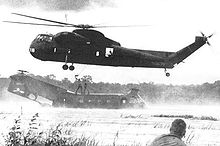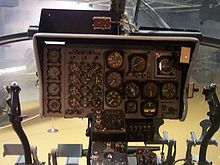Piasecki H-21
| Piasecki H-21 Workhorse | |
|---|---|
 H-21B "Workhorse" of the US Air Force |
|
| Type: | Transport helicopter |
| Design country: | |
| Manufacturer: | |
| First flight: |
April 11, 1952 |
| Production time: |
1954 to 1959 |
| Number of pieces: |
714 |


The Piasecki H-21 Workhorse (factory designation: PD-22 ) was a transport helicopter made in the USA . It had two main rotors in tandem configuration and could carry up to 20 fully equipped soldiers with a two-man crew. The H-21 was u. a. used in the Vietnam War. The civil version offered from 1958 was called the Vertol 44 (later Boeing-Vertol 44).
history
The development of the H-21 goes back to the Piasecki model PV-3 , better known under the US Navy name HRP-1 Rescuer ( first flight in March 1945). In 1949 the derived version PV-17 ( HRP-2 Rescuer ) followed, which had a completely new fuselage made of all-metal, while the engine (440 kW (600 PS) Pratt & Whitney R-1340 ) was taken over unchanged.
On April 11, 1952, the H-21 (factory designation PD-22), derived from the HRP-2 , flew for the first time. With its 845 kW radial engine , it had almost twice as high an engine power as the HRP-1 . Series production began in 1954 with the H-21A , referred to by Piasecki as the workhorse ("workhorse"). Until the end of production in 1959, a B and a C version were produced, which were equipped with more powerful engines. In the US armed forces , the H-21 was given the nickname Shawnee , which, as usual, was borrowed from an Indian tribal designation.
When the Piasecki Helicopter Corporation was renamed Vertol Aircraft Corporation in May 1956, the internal name of this helicopter changed from PD-22 to Model V-43 . The designation reform the US armed forces then brought Type CH-21 ( C argo H elicopter, engl. For transport helicopters) with itself. From the US soldiers he was nicknamed flying banana ("flying banana"; due to the curved shape of the trunk) or army mule ("army mule", based on Workhorse ).
Military operation
| (Partial) armed force | version | number of pieces |
|---|---|---|
|
|
H-21A, H-21B | 214 |
|
|
H-21C | 334 |
|
|
H-21C | 108 |
|
|
H-21C | 32 |
|
|
H-21C | 11 |
|
|
H-21C | 10 |
|
|
H-21C | 5 |
|
|
H-21C | 3 |
Production for USAF and US Army
As part of the Mutual Defense Aid Program (MDAP), the H-21 was also delivered to allied countries.
Acceptance of the Piasecki H-21 by the USAF and the US Army:
| version | 1952 | 1953 | 1954 | 1955 | 1956 | 1957 | 1958 | 1959 | TOTAL |
|---|---|---|---|---|---|---|---|---|---|
| YH-21 | 3 | 15th | 18th | ||||||
| H-21A | 20th | 12 | 32 | ||||||
| H-21B | 5 | 81 | 61 | 14th | 161 | ||||
| H-21C Army | 32 | 54 | 90 | 134 | 22nd | 2 | 334 | ||
| H-21A MDAP | 6th | 6th | |||||||
| H-21 MDAP | 6th | 6th | |||||||
| TOTAL | 3 | 35 | 55 | 135 | 151 | 148 | 28 | 2 | 557 |
Technical specifications

| Parameter | Data |
|---|---|
| crew | 2 |
| Passengers | 20 soldiers |
| Rotor diameter | 13.50 m |
| Hull length | 16.00 m |
| Length over all | 26.20 m |
| height | 4.70 m |
| Preparation mass | 3,990 kg |
| Takeoff mass | 6,950 kg |
| Cruising speed | 158 km / h |
| Top speed | 210 km / h |
|
Hover altitude with ground effect |
1,860 m |
| Service ceiling | 2,880 m |
| Range | 450 km |
| Engine | 1 Wright R-1820-103 - radial engine with 1,048 kW (1,425 hp) |
See also
Web links
Individual evidence
- ^ Zaire, World Air Forces - Historical Listings ( Memento from January 25, 2012 in the Internet Archive )
- ↑ The Aviation Forum 2 photos of Congolese H-21s
- ↑ Statistical Digest of the USAF 1952 , p. 158; 1953, p. 185 f .; 1954, pp. 70 f .; 1955, p. 80 f .; 1956, p. 91 f .; 1957, p. 97 f .; 1958, p. 72; 1959, p. 68


